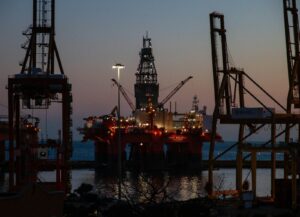More than 400 pieces of Alpine ice have been moved to a giant freezer – a first step in their journey to Antarctica.
The seemingly strange plan to send ice to the coldest place on Earth is part of a scientific mission to ‘rescue’ some of the world’s most endangered glacial ice.
Bubbles in old, deep glacial ice are frozen records of our past atmosphere.
Scientists say their purpose-built Antarctic ice bunker will keep these safe for future research.
‘What we know for sure is that the ice will not be here in 50 or 100 years time – any glacier below 3,500m altitude will be gone by the end of the century,’ explained Jerome Chappellaz from France’s National Centre for Scientific Research, one of the leaders of the project.
‘[In the Alps], we’re trying to recover ice cores from one of the glaciers that is in danger.’
That glacier is at Col du Dome – just below the peak of Mont Blanc. It is one of two that the team has chosen to provide their frozen library with ‘reference ice’ for regions where information on past climate and atmosphere is lacking.
The team set up a high altitude research camp on the ice while they worked. They have now successfully extracted three full ice cores, drilling their cylindrical cutting device through the entire 130m depth of the glacier.
Prof Carlo Barbante, from the Institute for Research and Development and the University of Venice – and another leading member of this Franco-Italian team – explained that the project at Col du Dome was a race against time.
‘We are losing a lot of mass of ice. We can already see that some of the surface layers of the glacier are percolating down into the deepest parts.
‘So that means that we are losing ice and we are mixing up information.’
The team, whose work was funded almost entirely by philanthropic donations, will next head to a site on the Illimani mountain in the Bolivian Andes. At 6,300m, that summit is too high for a helicopter, so heavy drills and other equipment will need to be carried.
The scientists will also have to carry every metre-long cylinder of ice back down the mountain in backpacks.
‘One-off chance’
Julian Dowdeswell, director of the UK’s Scott Polar Research Institute, praised the mission for its value to future scientists.
‘Over the last 20 to 30 years, ice core geochemistry has come a long way so it’s important to store [these cores] for the future as technology advances,’ he told BBC News.
‘[These glaciers] are melting, so this is a one-off chance.’
The Col du Dome ice will now be stored in a freezer at the University Grenoble Alpes, while the permanent snow cave is prepared over the next two years. That will be located close to the French-Italian Concordia Research Station, in the high altitude of the Antarctic Plateau, just over 1,500km from the South Pole.
‘Basically a glacier is a memory of our planet,’ said Jerome Chappellaz. ‘Many trace compounds [from the atmosphere] are found in the snowflakes and then in the glacier.
‘So by drilling through it, we go back in time and we can recover a book of what happened in our planet.’
















